

























Republic P-47D Thunderbolt (Bubbletop)
World War II single-engine single-seat fighter
Archive Photos 1
Republic P-47D-30-RA Thunderbolt (AF 44-32691) at the National Air and Space Museum Steven F. Udvar-Hazy Center, Chantilly, Virginia (Photo by Jim Hough)
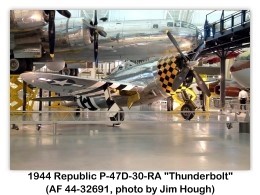
Republic P-47D-30-RA Thunderbolt (N767WJ, AF 44-32817) at the Tillamook Air Museum, Tillamook, Oregon (Photos by John Shupek)
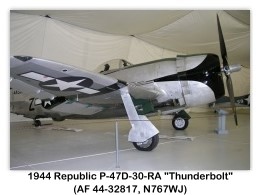
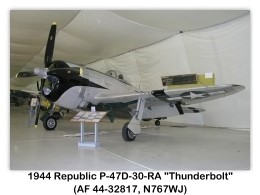
Republic P-47D-40-RA Thunderbolt (N444SU, AF 45-49181) c.2004 at the Kalamazoo Aviation History Museum, Portage, Michigan (Photos by John Shupek)
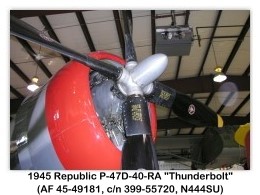
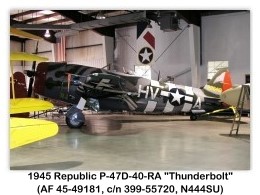
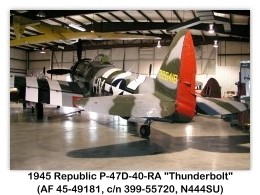
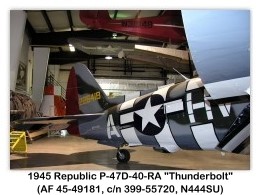
Republic P-47D-40-RA Thunderbolt-Big Chief (NX47RP, AF 45-49205) at the Palm Springs Air Museum, Palm Springs, California (John Shupek photos copyright © 2002 Skytamer Images)
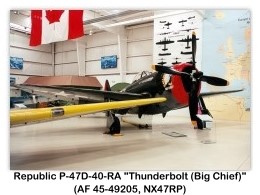
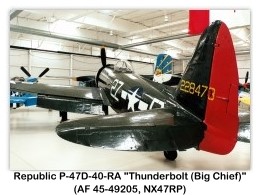
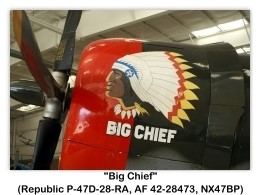
Republic P-47D-40-RA Thunderbolt (c/n 499-6808) on display (7/2/2006) at the Beijing Aviation Museum, Beijing, China (Photos by John Shupek)
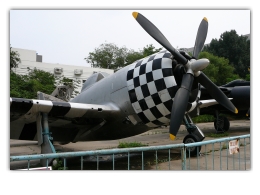
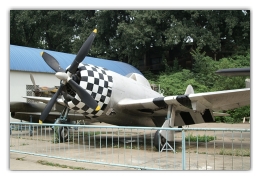
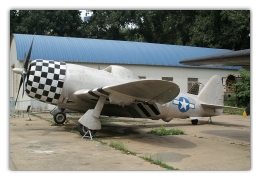
Overview 2
The specification to which the Republic P-47 Thunderbolt was designed was drawn up at Wright Field in June, 1940. The original Republic XP-47 design was for a lightweight interceptor fighter fitted with an Alison V-1710 liquid-cooled engine and an armament of one 50 cal. and one 30 cal. guns and provision for two additional 30 cal. wing guns. This was not preceded with.
The first experimental prototype of the Thunderbolt as it is known today was the XP-47B, which was flown from Farmingdale to Mitchell Field on 6 May 1941. Production got underway in the following November. The first production P-47B was delivered on 18 March 1942.
Republic P-47 Thunderbolts began to arrive in Britain in November 1942, and the first operational mission with the 8th Air Force was made on 8 April 1943. The first mission with auxiliary fuel tanks took place in July and during the last few weeks of 1943 the first fighter-bomber missions with two 500 lb bombs were made. The first pairs of 1,000 lb bombs were carried by the Republic P-47 Thunderbolts in Italy early in 1944.
The Thunderbolt, in addition to being a standard fighter in the U.S. Army Air Forces, was also supplied, under Lend/Lease to Great Britain, Russia, France and Brazil. The RAF used to Thunderbolt in India and Burma. The Brazilian fighter squadron which served in Italy was equipped with Thunderbolts.
The 10,000th Thunderbolt came off the assembly lines at Farmingdale on 20 September 1944, just two and a half years after the first Republic P-47B Thunderbolt was delivered to the US Army Air Forces.
The following are the principal production and development versions of the Thunderbolt:
Republic P-47B
- 2,000 hp Wright R-2800-21 eighteen-cylinder radial air-cooled engine with exhaust-driven turbo-supercharger.
- Curtiss Electric four-blade constant-speed airscrew 12 ft 2 in (3.7 m) diameter.
- Self-sealing fuel tanks of 307 U.S. gallons capacity.
- Armor protection for pilot.
- Eight 50 cal. machine-guns.
- Length: 34 ft 10 in (10.6 m).
Republic P-47C
- Similar to P-47B but fitted with special shackles to carry one 200 U.S. gallon auxiliary fuel tank under the fuselage.
- Length overall: 35 ft 7 in (10.8 m).
Republic P-47D (Thunderbolt I and II)
- First models similar to the P-47C but fitted with universal shackles under fuselage for either droppable fuel tank or 500 lb. bomb, and similar wing racks.
- Later models fitted with water injection, which added several hundred horse-power for emergency use.
- Improved turbos.
- Wide-blade airscrews 13 ft (3.96 m) diameter, which added 400 ft per minute to the climb.
- Increased fuel capacity, which increased the radius of action to 637 miles (920 km).
- Jettisonable standard canopy and, later, a new jettisonable "blister" hood and flat bulletproof windscreen.
- The bomb load was increased from two 500 lb to two 1,000 lb and one 500 lb bombs, and three auxiliary fuel tanks could be carried externally on the same racks.
- Various combinations of bombs and tanks could be carried to suit tactical requirements.
- After the introduction of the "blister hood" in the P-47D-25 a dorsal fin was added.
- Length overall: 36 ft 1-3/16 in (11 m).
Republic XP-47E
- An experimental version of the P-47B fitted with a pressure cabin.
- Only one aircraft was so fitted.
Republic XP-47F
- Another experimental version of the P-47B fitted with laminar flow wings.
Curtiss P-47G
- Similar to P-47C and early P-47D but built by Curtiss Airplane Division at Buffalo, N.Y.
- Progressive developments introduced in P-47D, including water-injection and racks for bombs or auxiliary fuel tanks, also incorporated in Curtiss P-47G.
Republic XP-47H
- A modification of the P-47B to test the experimental Chrysler XIV-2220 inverted Vee liquid-cooled engine.
Republic XP-47J
- Similar to the P-47D but with many engineering changes.
- Weight reduced by 1,000 lbs (454 kg).
- Reduced diameter engine cowling with cooling fan.
- Redesigned wings.
- Many features of this experimental model were incorporated in the production P-47M and P-47N.
Republic P-47M
- A special model which went into service in Europe early in 1945.
- Fitted with a P-47D wing.
- P-47N fuselage and a 2,100 hp Pratt & Whitney R-2800-57 engine with larger supercharger and improved water-injection system.
- Was claimed to be the fastest airscrew-driven airplane in service at that time and to be successful in combating German jet propelled fighters.
Republic P-47N
- A long-range fighter developed for bomber escort duties in the Pacific theater.
- Same fuselage and power-unit as the P-47M but fitted with re-designed wings of 18 in. greater span and 22 ft² increased area and with squared wing-tips and larger ailerons.
- Increased petrol capacity with eight additional tanks, one in the leading-edge of each wing and three near each wheel well.
- Strengthened landing-gear with wider tread.
- Armament the same as for previous P-47’s but provision for two 500 lb bombs and ten 5 in. rockets under the wings.
- Maximum weight over 20,000 lb (9,080 kg).
Specifications and Performance Data 2,3
Type 2
- Single-seat long-range fighter or fighter-bomber.
Wings 2
- Low-wing cantilever monoplane.
- Republic S-3 wing section.
- Aspect ratio 5.61
- Incidence +1°
- Dihedral (upper surface) 4°
- Wings taper in chord and thickness, the leading-edge having a straight taper of 3° and the trailing-edge a curved taper, terminating in rounded detachable wing-tips.
- Ailerons on skew hinges.
- Hydraulically-operated NACA slotted trailing-edge flaps between ailerons and fuselage.
- The flaps are on trapezoidal linkage hinges which permit them, when lowered, to move first aft then down and, when retracted, first up and then forward.
- Later P-47’s have electrically-operated dive-recovery flaps just forward of the main flaps.
- When in retracted position these lie flush with underside of wing.
Fuselage 2
- Oval-section all-metal monocoque structure.
Tail Unit 2
- Cantilever monoplane type.
- All-metal structure with metal-covered fixed surfaces, rudder and elevators.
- Control surfaces statically and aerodynamically balanced and provided with trimming-tabs.
Landing Gear 2
- Retractable type.
- Cantilever shock-absorber struts retract inwardly, the wheels being raised into wells in the underside of the wings.
- Fairing plates on legs and wheels and hinged fairings on inner edges of wells close apertures when wheels are raised.
- Retractable tail-wheel.
Power Plant 2, 3
- P-47B: One 2,000 hp Pratt & Whitney R-2800-21 Double Wasp eighteen-cylinder radial air-cooled engine.
- P-47C: One 2,000 hp Pratt & Whitney R-2800-21 Double Wasp eighteen-cylinder radial air-cooled engine.
- P-47D: One 2,000 hp Pratt & Whitney R-2800-21 Double Wasp eighteen-cylinder radial air-cooled engine.
- P-47D-25: One 2,300 hp Pratt & Whitney R-2800-59 Double Wasp eighteen-cylinder air-cooled engine.
- P-47G: One 2,000 hp Pratt & Whitney R-2800-21 eighteen-cylinder radial air-cooled engine.
- P-47M: One 2,800 hp Pratt & Whitney R-2800-57 Double Wasp eighteen-cylinder radial air-cooled engine.
- P-47N: One 2,800 hp Pratt & Whitney R-2800-77 Double Wasp eighteen-cylinder radial air-cooled engine.
- G.E. turbo supercharger located in rear fuselage.
- Air fed to impeller through scoop in lower portion of cowling and compressed air led forward to carburetor through intercoolers in side of fuselage.
- Exhaust gases are ducted aft to supercharger through throttles which control speed of turbine and after passing through turbine are ejected through large diameter pipe near tail-wheel.
- Four-bladed Curtiss Electric constant speed full-feathering airscrew.
- Two self-sealing and armored fuel tanks in fuselage, the main tank (270 U.S. gallons) aft of the fireproof bulkhead and auxiliary tank (100 U.S. gallons), beneath pilot’s seat.
- Auxiliary droppable fuel tanks of various capacities may be carried beneath fuselage and/or wings.
- In P-40N greatly increased fuel capacity in eight additional wing tanks, nearly doubling the former total internal capacity.
- Oil tank in front of firewall and two oil coolers in lower portion of engine cowling, one on each side of main air duct to supercharger.
Accommodation2
- Enclosed cockpit over trailing-edge of wing.
- Sliding moulded plastic "blister" type canopy.
- Bullet-proof windscreen and front and rear armour protection for pilot.
- Cockpit and other vulnerable points armored.
Dimensions3
- Span (P-47B): 40 ft 9 in
- Span (P-47C): 40 ft 9 in
- Span (P-47D): 40 ft 9 in
- Span (P-47D-25): 40 ft 9 in
- Span (P-47G): 40 ft 9 in
- Span (P-47M): 40 ft 9 in
- Span (P-47N): 42 ft 7 in
- Length (P-47B): 35 ft 0 in
- Length (P-47C): 36 ft 1 in
- Length (P-47D): 36 ft 1 in
- Length (P-47D-25): 36 ft 1 in
- Length (P-47G): 36 ft 1 in
- Length (P-47M): 36 ft 4 in
- Length (P-47N): 36 ft 1 in
- Height (P-47B): 12 ft 8 in
- Height (P-47C): 14 ft 2 in
- Height (P-47D): 14 ft 2 in
- Height (P-47D-25): 14 ft 2 in
- Height (P-47G): 14 ft 2 in
- Height (P-47M): 14 ft 9 in
- Height (P-47N): 14 ft 8 in
- Wing area (P-47B): 300 ft 2
- Wing area (P-47C): 300 ft²
- Wing area (P-47D): 300 ft²
- Wing area (P-47D-25): 300 ft²
- Wing area (P-47G): 300 ft²
- Wing area (P-47M): 308 ft²
- Wing area (P-47N): 322 ft²
Weights 3
- Weight empty (P-47B): 9,346 lb
- Weight empty (P-47C): 9,900 lb
- Weight empty (P-47D): 9,900 lb
- Weight empty (P-47D-25): 10,000 lb
- Weight empty (P-47G): 9,900 lb
- Weight empty (P-47M): 10,423 lb
- Weight empty (P-47N): 11,000 lb
- Weight gross (P-47B): 13,360 lb
- Weight gross (P-47C): 14,925 lb
- Weight gross (P-47D): 14,925 lb
- Weight gross (P-47D-25): 19,400 lb
- Weight gross (P-47G): 14,925 lb
- Weight gross (P-47M): 15,500 lb
- Weight gross (P-47N): 20,700 lb
Performance3
- Maximum speed (P-47B): 429 mph at 27,800 ft
- Maximum speed (P-47C): 433 mph at 30,000 ft
- Maximum speed (P-47D): 433 mph at 30,000 ft
- Maximum speed (P-47D-25): 428 mph at 30,000 ft
- Maximum speed (P-47G): 433 mph at 30,000 ft
- Maximum speed (P-47M): 473 mph at 32,000 ft
- Maximum speed (P-47N): 467 mph at 32,500 ft
- Cruising speed (P-47B): 335 mph
- Cruising speed (P-47C): 350 mph
- Cruising speed (P-47D): 350 mph
- Cruising speed (P-47D-25): - mph
- Cruising speed (P-47G): 350 mph
- Cruising speed (P-47M): - mph
- Cruising speed (P-47N): 300 mph
- Climb (P-47B): 6.7 min to 15,000 ft
- Climb (P-47C): 11 min to 20,000 ft
- Climb (P-47D): 11 min to 20,000 ft
- Climb (P-47D-25): 9 min to 20,000 ft
- Climb (P-47G): 11 min to 20,000 ft
- Climb (P-47M): 13.4 min to 32,000 ft
- Climb (P-47N): 14.2 min to 25,000 ft
- Service ceiling (P-47B): 42,000 ft
- Service ceiling (P-47C): 42,000 ft
- Service ceiling (P-47D): 42,000 ft
- Service ceiling (P-47D-25): 42,000 ft
- Service ceiling (P-47G): 42,000 ft
- Service ceiling (P-47M): 41,000 ft
- Service ceiling (P-47N): 43,000 ft
- Range (P-47B): 550 st. miles
- Range (P-47C): no data
- Range (P-47D): no data
- Range (P-47D-25): 475 st. miles
- Range (P-47G): no data
- Range (P-47M): 530 st. miles
- Range (P-47N): 800 st. miles
Armament3
- Guns (P-47B): Eight 50 cal. machine-guns, four in each wing outboard of landing gear.
- Guns (P-47C): Eight 50 cal. machine-guns, four in each wing outboard of landing gear.
- Gums (P-47D): Eight 50 cal. machine-guns, four in each wing outboard of landing gear.
- Guns (P-47D-25): Eight 50 cal. machine-guns, four in each wing outboard of landing gear.
- Guns (P-47G): Eight 50 cal. machine-guns, four in each wing outboard of landing gear.
- Guns (P-47M): Eight 50 cal. machine-guns, four in each wing outboard of landing gear.
- Guns (P-47N): Eight 50 cal. machine-guns, four in each wing outboard of landing gear.
- Guns electrically-fired.
- Combat cine-camera in port wing root.
- Maximum bomb load (P-47B): n/a
- Maximum bomb load (P-47C): 1 × 500 lb
- Maximum bomb load (P-47D): 1 × 500 lb
- Maximum bomb load (P-47D-25): 2 × 1,000 lb
- Maximum bomb load (P-47G): 1 × 500 lb
- Maximum bomb load (P-47M): n/a
- Maximum bomb load (P-47N): 2 × 1,000 lb
- Bombs may be carried under fuselage or wings.
- Maximum bomb load: two 1,000 lb. bombs, one under each wing, and one 500 lb. bomb under the fuselage.
- Ten 5 in. velocity aircraft rockets may be carried, the latest type of rocket needing neither launching-rails or tracks.
Serial Numbers 3
- XP-47B: 40-3051
- P-47B: 41-5895/6065
- P-47C: 41-6066/6667
- P-47D-RA: 42-22250/23299; 42-27389/29466; 43-25254/25733; 44-32668/33867; 44-89684/90483; 45-49090/49554.
- P-47D-RE: 42-7853/8702; 42-25274/27388; 42-74615/76614; 44-19558/21107.
- P-47G-CU: 42-24920/25273.
- XP-47J: 43-46952.
- P-47M-RE: 44-21108/21237.
- P-47N-RA: 45-49975/50123.
- P-47N-RE: 44-87784/89450
References
- Photos: John Shupek
- Bridgman, Leonard (editor.), The Republic Thunderbolt, Jane’s All The World’s Aircraft 1945-46, London: Sampson Low, Marston & Company, Ltd., 1945, pages 300c-302c
- Swanborough, Gordon and Peter M. Bowers. Republic P-47 Thunderbolt, United States Military Aircraft Since 1908, Putnam & Company Limited, London, 1971, ISBN 0-370-00094-3, pages 355-461.












































































